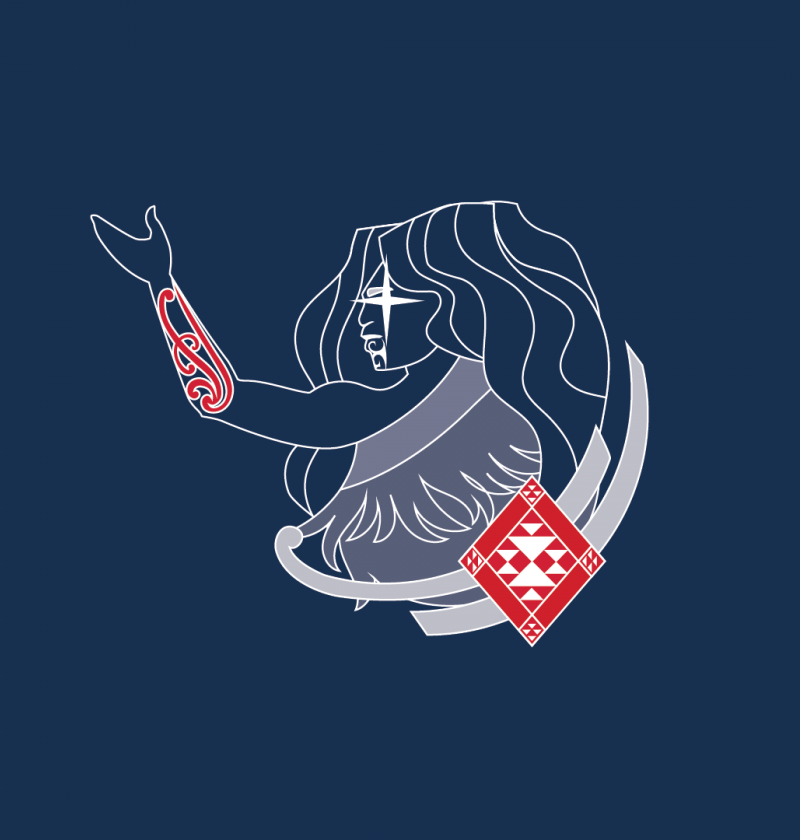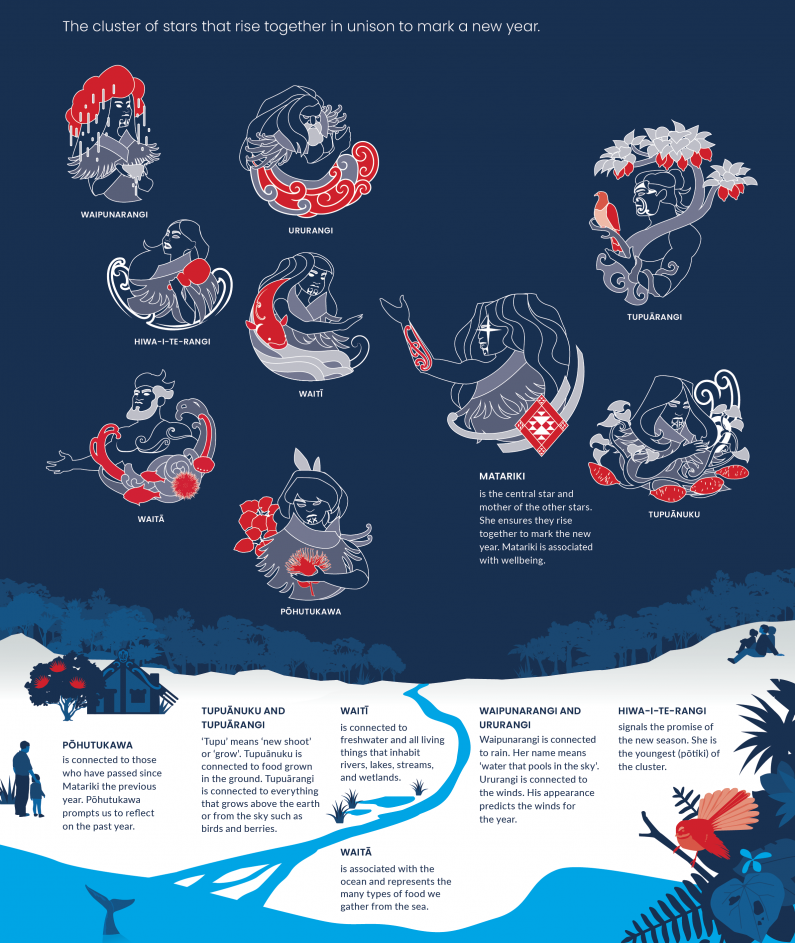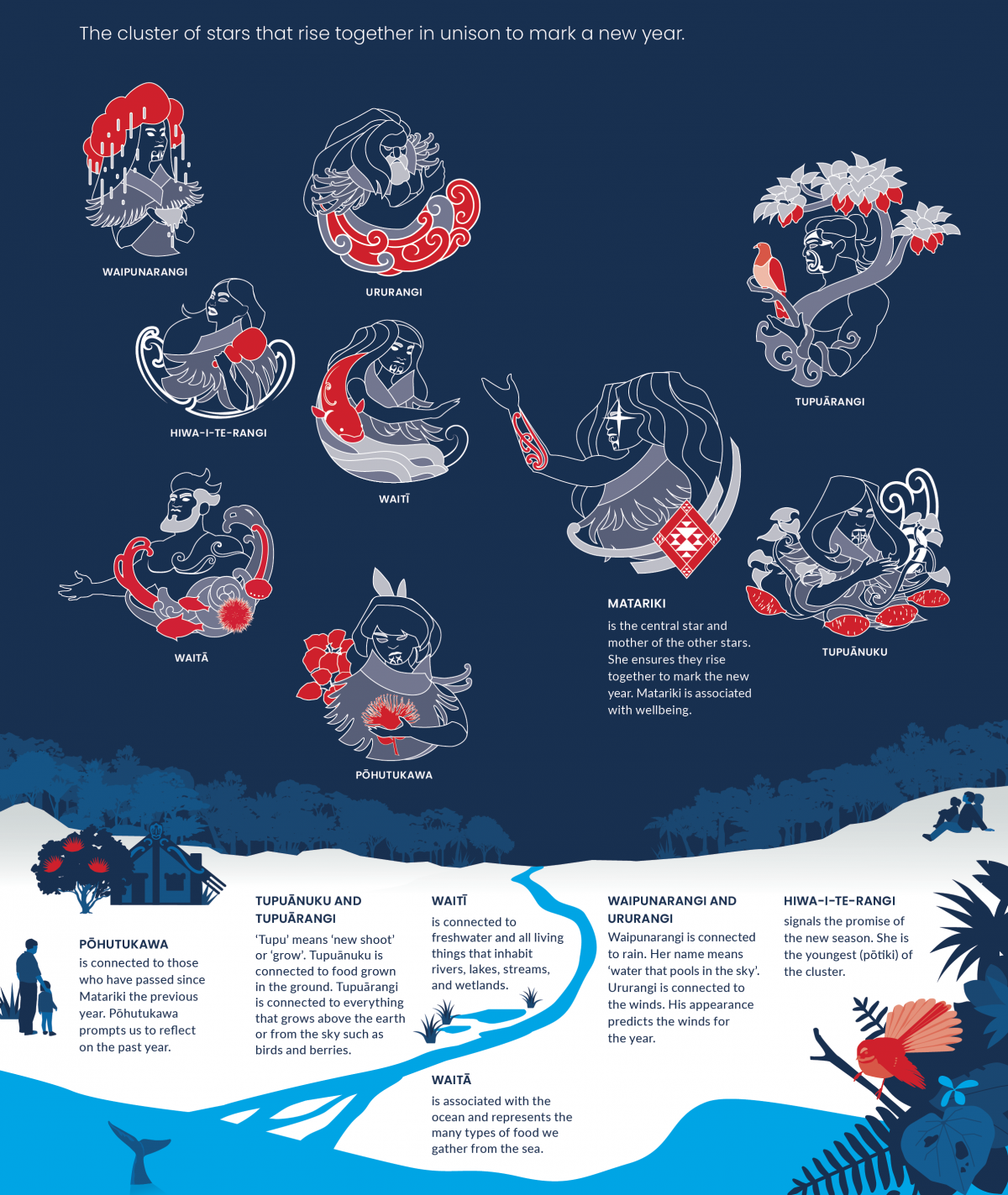Matariki The stars of the year (Ngā whetū o te tau)

Matariki atua ka eke ki te rangi e
Te kaiwhakahaere o te kāhui
Haria mai rā te oranga o te tangata
E tū e, te paki o Matariki
Matariki rising in the sky
The conductor of the cluster
Bestow health upon all people
Stand bright Matariki, a sign of wellbeing
Matariki is the name given to the central star within the Matariki cluster, as well as the entire cluster itself. Matariki is the mother (whaea) star of the cluster. She ensures the stars of the cluster rise together in unison to mark a new year* and signal the health of the environment.
*Some iwi herald the new year with the rising of a star called Puanga (Rigel), found in the Orion constellation (Matamua 2017).
Matariki is linked to the wellbeing of people. The phrase ‘te paki o Matariki’ means ‘the bright star of Matariki’ and is a sign of wellbeing and peace. The appearance of the Matariki star is one of several signals used to determine how plentiful harvests will be over the coming year, which is of critical importance to the ongoing wellbeing of people.
In some iwi traditions, Matariki’s husband is the atua** Rehua***, who is connected with healing (rongoā). The saying ‘Matariki huarahi ki te oranga tangata’ (‘Matariki, pathway to the wellbeing of people’) reaffirms this association with health (Riley, 2013).
**Atua is a uniquely Māori understanding and personified form of natural realms.
***Rehua is sometimes associated with the star Antares, but is not part of the Matariki cluster.
Wellbeing has different meanings for different people (Roberts et al, 2015). It encompasses a vast range of elements, and has been conceptualised differently according to culture, working concepts, and application. The way people define and understand their relationships with the rest of the living world is diverse and evolving. However, as the Parliamentary Commissioner for the Environment recently noted, it is broadly agreed that our economic and non-economic wellbeing are linked to the environment, now and in the future (PCE, 2021b).
In recent decades a growing body of research and scientific evidence has demonstrated the link between environment and wellbeing (Capaldi et al, 2015; Chan et al, 2016; Díaz et al, 2018; Harvey, 2021; Martin et al, 2020; McMahan & Estes, 2015; McMeeking et al, 2019; Richardson et al, 2021; Roberts et al, 2015; Twohig-Bennett & Jones, 2018).
There are also many conceptual frameworks to describe and visualise the connections between environment and wellbeing of today’s and tomorrow’s generations (Ausseil et al, 2021a; Naeem et al, 2016). One government perspective, for example, focuses on the things that matter for New Zealanders’ wellbeing, now and into the future. The Treasury’s Living Standards Framework characterises wellbeing in three levels (New Zealand Treasury – Te Tai Ōhanga, 2021). One level captures the resources and aspects of our lives that have been identified as important for our wellbeing as individuals, families (whānau), and communities. A second level captures the role our institutions and organisations play in facilitating the wellbeing of individuals and collectives, as well as safeguarding and building our national wealth. And a third level captures how wealthy we are overall, including aspects of wealth not fully captured in the system of national accounts such as human capability and the natural environment.
He Ara Waiora is another wellbeing framework, used by Treasury and He Pou a Rangi – Climate Change Commission (McMeeking et al, 2019) and informed by mātauranga Māori (Māori knowledge). For this framework, wellbeing has been described using the term ‘waiora’, a broad conception of human wellbeing, grounded in water (wai) as the source of life (ora). This view of wellbeing has spirit (wairua) at the centre to reflect that it is the foundation or source of wellbeing. The environment (te taiao) is paramount and inextricably linked with human wellbeing. Humans have responsibilities and obligations to sustain and maintain the wellbeing of te taiao. The human domain (te ira tangata) encapsulates human activities and relationships, including the relationships between generations. The concept of mana (power, authority) is key to wellbeing.
While Matariki is used to tell the story of the connection between environment and wellbeing, this report is informed by a range of perspectives and conceptual frameworks, including those described above.
In the Māori worldview (te ao Māori), Matariki and wellbeing are intrinsically connected with mauri. Mauri is an important Māori concept that describes the health and vitality of living systems. It has been described as the spark of life and active component of that life (Mead, 2003), and the binding force that holds together the physical and spiritual components of a being or thing (Durie, 1998; Morgan, 2006). Mauri is found in water, land, and forests as well as mist, wind, soil, and rocks (Hikuroa et al, 2011). The essential bond between the physical and spiritual is weakened when actions negatively impact the mauri of something. Broken bonds can lead to the separation of the physical and spiritual elements causing the loss of capacity to support life. (Morgan, 2006).
The Parliamentary Commissioner for the Environment (2019), states that many ‘non-Māori New Zealanders would also probably welcome a way to describe a more holistic account of ecological functioning that sits uneasily with whatever concepts – issues, themes, domains – have been used to simplify highly complex systems’. The idea of mauri, and the environment as an organic, living entity, has been difficult to include in past environmental reports. Yet mauri has been used by many scientists to describe the state and sustainability of a particular environment and measures have been created to assist this (Morgan, 2006). These cases provide good examples of how a Māori concept and science can work together to inform local environmental health.

The cluster of stars that rise together in unison to mark a new year:

The cluster of stars that rise together in unison to mark a new year:

Matariki The stars of the year (Ngā whetū o te tau)
April 2022
© Ministry for the Environment